 |
 |
 |
[ Go to Bottom ]
-
 |
 |
 |
[ Go to Bottom ]
*** Welcome ***
to the Pa Kua Chang (Ba Gua Zhang) Website of Sifu Park Bok-Nam!
We hope that you will find this site to be interesting and informative,
and will use it as a starting point for
learning
more about the Pa Kua Chang of Lu Shui-Tian.
======> NOTE: This site is best observed with Netscape
Navigator
<======
|
= THIS EDITION = Featured in this edition of the FYI Page: . |
by Francis Hriadil, . Boston Student Group
|
|
| Master Park places a strong emphasis on the "underlying principles" that form the basis of the Pa Kua Chang of Lu Shui-Tian. Since the groundbreaking work, "The Fundamentals of Pa Kua Chang: The Method of Lu Shui-T'ien as Taught by Park Bok-Nam," many instructors of Pa Kua (as well as other martial arts) have adopted the use of this same terminology. It is now customary to see various teachers talking or writing about the principle or principles of their particular system, style, techniques, and/or movements. |
| Where appropriate, this is good. However, Master Park wishes all students of Pa Kua, or any other martial art, to understand that simply calling something a "principle" does not make it a "true principle" in the strictest sense. Master Park does not take this lightly and is very exact in his use of this term specifically as it relates to Pa Kua Chang. |
| In the strictest sense, a principle is defined as a fundamental truth or law of nature. A true principle is not an artificial fabrication. It is not "made up." It does not arise simply as an idea in the mind of an instructor based on his or her own thinking; nor does it originate out of a particular movement or form. |
| True principles derive from a critical and comprehensive study of nature and the physical universe. This includes the study of matter, energy, life, their relationships, their interrelationships, and their transformations. Valid principles comprise a set of fundamental truths that have been identified based on careful, detailed, and lengthy analysis. They have developed over years, decades, or even centuries of research. They have stood the test of time and are subject to repeatable verification by observation, experience, or experiment. They comprise a coherent body of empirical knowledge, a science and a philosophy. As such, each true principle has a basis, a reason, and a justification in nature providing the grounds for its validity. |
| All of the underlying principles that form the substance of the Pa Kua of Lu Shui-Tian adhere to this strict definition. |
PRINCIPLE . . . .<=== . . . . PHILOSOPHY . . . .<=== . . . . NATURE
| All principles come from a philosophy based on the study of nature that has evolved over centuries of human research. They are rooted in the real world, and are governed by the laws of physics and human physiology. This is the legacy and the gift that has been handed down to students involved in the study of Pa Kua Chang as taught by Park Bok-Nam. |
| In Pa Kua (as in any serious area of study), it is extremely important to understand where the "principle" comes from and why the "principle" is valid? The path to knowledge and understanding does not begin until the first question is asked. And, the most important question that can be asked is "why?" |
= = =
[ Go
to Top
] [
Return
to This Edition Index ] [ Go
To
Bottom ]
|
|
REFLEX BODY RESPONSE
[Adapted and Re-edited by F.
Hriadil]
| Success in internal boxing requires an experiential understanding of the principle the Chinese call Wu Wei. |
| Wu Wei is one of the most important principles applied to any internal martial art in a self-defense situation. Wu literally means "non", "negative", "not" or "none" and Wei means "action", "doing", "striving", or "straining." The common English translation of wu wei is "non-action," however, many people incorrectly interpret this translation to mean laziness or passivity. |
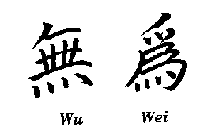
| Wu Wei (in actuality) means "action through non-action." It is spontaneous action which does not arise from a motive or seek a result. In modern phraseology, wu wei can be interpreted as "going with the flow" or "rolling with the punches", but requires that the practitioner do so spontaneously, skillfully, efficaciously, and along the line of least resistance. When the practitioner has embodied the principle of wu wei in martial arts, he or she has developed an innate body response which is spontaneous, correct, without thought, and requiring what appears to be little effort in the execution of a difficult task. This response is based on a knowledge of principles, structures, alignments, rhythm, timing, optimum angles of attack and defense, and economy of motion which is resident in the body, not just in the mind. Wu Wei does not stem from intellectual intelligence, but from an "unconscious" or innate intelligence in the physical body that can only be developed through hours of correct repetitive training. |
| Master Park emphasizes the importance of this "body knowledge" in his teaching. He believes that when something is "known" in the body, it becomes a reflex action which will not soon be forgotten. His approach to Pa Kua Chang instruction is to start the student with very simple movements and exercises. These exercises, which are based on fundamental principles, are repeated hundreds, if not thousands of times under Master Park's watchful eye until the student has embodied the principle and it becomes a natural reflex. Master Park states that the exercise should be repeated so many times that when the student stops, the body still feels as though it is going through the motions of the exercise -- like when getting back on land after a long boat ride and the body still feels like it is rocking back and forth. |
| Once Master Park feels the student has "body knowledge" of the principle as it is applied in the simple exercise, he will teach the student a slightly more difficult exercise with which to work in the same manner. Master Park feels that if the student is initially given exercises that are too complex, or is given too many different exercises to practice, then he or she will never develop skillful innate body response. He is fond of saying that "If I give you too much food, you cannot digest it all and some of it gets thrown away. It is the same with Pa Kua. If you are taught too much at one time, you will never digest it all." |
| The development of skill in internal martial arts not only requires that the student work to gain this "body knowledge" of the principles, but the body also has to change and develop physically. Flexibility, balance, and overall coordination are important components of training the body for martial arts. However, since Pa Kua Chang is an "internal" style, additional training which works to properly develop the tendons, bones, joints, ligaments, and secondary muscle groups must be executed in a progressive manner. Development of the physical body requires many hours of repetitive practice with fundamental drills designed to initiate such development. The student needs to develop what Master Park refers to as the "kung fu body." |
= = =
[ Go to Top
] [
Return
to This Edition Index ] [ Go
To
Bottom ]
. . . . . . . . . .
DEVELOPING THE "KUNG FU BODY"
| The Pa Kua Chang practitioner's body movement has typically been compared to that of a snake or dragon. References to snake or dragon like movement in Pa Kua Chang literature are numerous and many of the popular Pa Kua forms are called "snake" or "dragon" form Pa Kua (she hsing and lung hsing respectively). The turning, twisting, coiling, circling and whipping movements of the skilled practitioner will indeed remarkably resemble the movements of a snake and have inspired further descriptive analogies of Pa Kua movement such as yu shen (swimming body) or lien huan (continuous circling). |
| The snake-like movements of the Pa Kua practitioner are never restricted to the arms, but involve a connected full body movement. There are no breaks or "dead spots" along the chain of movement from the foot to the hand. Movement in every part of the body is supple, smooth, fluid, and continuous. In order to accomplish this technique, the practitioner must be extremely flexible in the joints, especially the hips (yao k'ua), waist, spine, and shoulders. Full body integration and connection in conjunction with the flexible, relaxed, and unified movement are prerequisite to correct Pa Kua Chang technique application. |
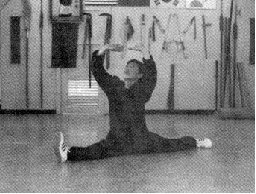
| Development of a body capable of this great degree of flexibility and connection (what Master Park refers to as a "kung fu body") requires training exercises designed to develop muscle, ligament, and joint flexibility, and training the body to move in a unified manner. In addition to overall body flexibility, integration, and coordination, development of internal martial arts power, or the ability to apply great force through very small body articulations, also requires repetitive training drills designed to isolate and train secondary muscles groups, tendons, and joints. To be trained properly and completely, these components are trained in isolation before being applied in Pa Kua Chang techniques. |
| Another important component in development of the "kung fu body" is a balanced, unified, smooth movement of chi throughout the body. The classics of Pa Kua Chang speak frequently of the "I chi," or "one chi." This is referring to the ability of the practitioner to unify the movement and function of the body in such a way that the entire body, mind, and spirit are working to achieve a common goal in a given instant, creating a "whole body power." If the body's chi is not full and balanced, the body will not work in complete harmony and the power will not be full. There will be "weak links in the chain." |
| Master Park believes that learning to apply the complex Pa Kua Chang forms before the body is well on its way to being developed properly in terms of flexibility, strength, balance, integration, alignment, and coordination is analogous to entering high school without first learning how to read. Master Park is fond of saying, "You cannot give a baby steak; a baby needs milk." |
= = =
[ Go to Top
] [
Return
to This Edition Index ] [ Go
To
Bottom ]
1997 SUMMER TRAINING CAMP
- [ June 13 to June 17 ] -
If you were not fortunate enough to attend this year's summer training camp,
here is some of what you missed! Five solid days of . . . . .
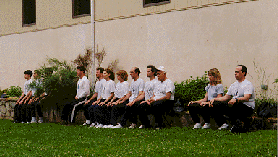 |
- Pa Kua Theory and Principles - Basic Exercises - Chi Kung (Qi Gong) - Breathing and Meditation - Pa Kua Palm Training |
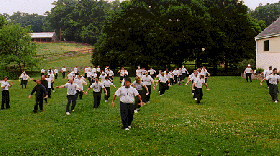 |
- Pa Kua Body
Training
- Pa Kua Footwork - Eight Animal Circle - Combat Circle Walking - Yin/Yang Circle Walking |
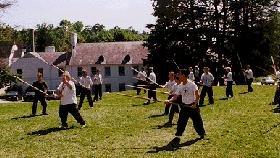 |
- Fighting Principles
and Applications - Research Sparring - Reflex Body Response - Pa Kua Staff Training - Pa Kua Broadsword |
Mark your calendars for next June so you'll be sure to make it next year!
= = =
[ Go to Top
] [ Return
to
This Edition Index ] [ Go To
Bottom ]
Submit comments, suggestions, etc. to E-Mail:
[ Go to Top ]
 |
 |
 |